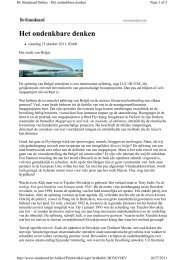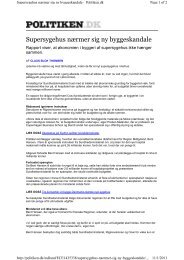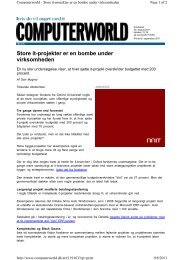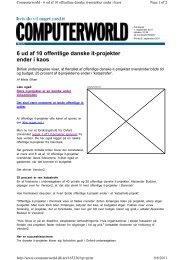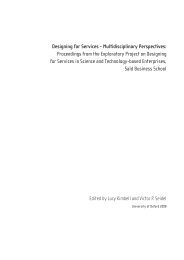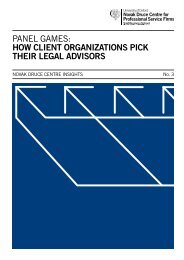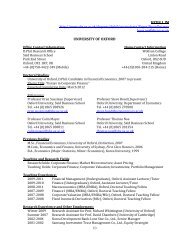Who benefits from the leverage in LBOs? - Said Business School ...
Who benefits from the leverage in LBOs? - Said Business School ...
Who benefits from the leverage in LBOs? - Said Business School ...
You also want an ePaper? Increase the reach of your titles
YUMPU automatically turns print PDFs into web optimized ePapers that Google loves.
different underly<strong>in</strong>g assumptions regard<strong>in</strong>g <strong>the</strong> future excess cash flows of our sample<br />
companies and <strong>the</strong> portion of this cash used to repay debt pr<strong>in</strong>cipal.<br />
The assumptions of scenario one result <strong>in</strong> amounts of excess cash flows at <strong>the</strong><br />
higher end of what might be possible. All cash is <strong>the</strong>n used <strong>in</strong> every year to repay debt<br />
pr<strong>in</strong>cipal. Hence, <strong>the</strong> amount of outstand<strong>in</strong>g debt and implied <strong>in</strong>terest expenses <strong>in</strong> future<br />
years decrease relatively quickly and <strong>the</strong> additional tax shields become comparably smaller.<br />
At <strong>the</strong> o<strong>the</strong>r extreme, <strong>in</strong> scenario eight we use assumptions result<strong>in</strong>g <strong>in</strong> lower excess cash<br />
flows <strong>in</strong> future years. Only <strong>the</strong> m<strong>in</strong>imum of <strong>the</strong>se amounts is <strong>the</strong>n used to repay debt<br />
pr<strong>in</strong>cipal. Hence, <strong>the</strong> companies under this scenario have higher <strong>in</strong>terest expenses, result<strong>in</strong>g<br />
<strong>in</strong> comparably higher additional tax shields. However, such a slow pace of debt repayment<br />
would likely result <strong>in</strong> covenant breaches of debt-to-EBITDA ratios <strong>in</strong> credit agreements,<br />
and PE sponsors would face substantial problems sell<strong>in</strong>g a company that rema<strong>in</strong>ed so<br />
highly <strong>leverage</strong>d. Scenarios one and eight <strong>the</strong>refore put bounds on <strong>the</strong> reasonable estimates<br />
for <strong>the</strong> anticipated tax sav<strong>in</strong>gs associated with <strong>the</strong> LBO.<br />
The most likely scenarios, that approximate LBO sponsors’ expectations, are<br />
probably towards <strong>the</strong> middle of our range of scenarios. In Figure IV we show <strong>the</strong> evolution<br />
of debt pr<strong>in</strong>cipal and <strong>the</strong> ratio of debt to EV (estimated as projected EBITDA times <strong>the</strong><br />
EV/EBITDA multiple observed at entry) for scenarios 1, 4 and 8. In our regression analysis<br />
we focus on scenario 4, which assumes a 5% expected growth rate for EBITDA, no change<br />
<strong>in</strong> capex relative to pre-LBO levels, a full sweep of excess cash to repay debt, and no<br />
<strong>in</strong>terest payments on any PIK notes. Although we estimate <strong>the</strong> <strong>in</strong>cremental tax sav<strong>in</strong>gs for<br />
up to 10 years – which is clearly longer than <strong>the</strong> <strong>in</strong>tended hold<strong>in</strong>g period for PE sponsors –<br />
under scenario 4 by year 6 <strong>the</strong> ratio of debt to enterprise value has fallen to around 40%,<br />
and so <strong>the</strong> bulk of <strong>the</strong> NPV of <strong>the</strong> <strong>in</strong>cremental tax sav<strong>in</strong>gs will have accrued by this stage.<br />
Over <strong>the</strong> first two to three years <strong>the</strong> amounts of outstand<strong>in</strong>g debt pr<strong>in</strong>cipal do not<br />
differ very much. In later years higher differences <strong>in</strong> <strong>in</strong>terest payments are partly offset due<br />
to stronger capitalization effects. Thus, <strong>the</strong> numbers <strong>in</strong> Table IX vary <strong>in</strong> a limited range<br />
throughout all scenarios (this is visualized <strong>in</strong> Figure V). For <strong>the</strong> median company <strong>in</strong> our<br />
sample <strong>the</strong> present value of <strong>the</strong> additional tax shields is <strong>in</strong> <strong>the</strong> range of 42.3% to 59.3% of<br />
<strong>the</strong> one-day premium (<strong>in</strong> cash terms). Between 12% and 21% of <strong>the</strong> companies have new<br />
17



